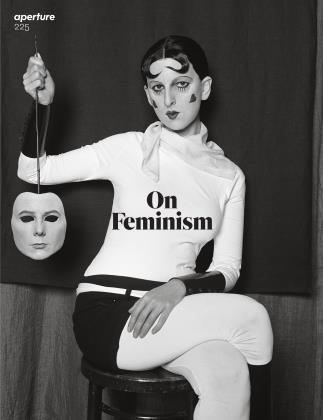COSEY FANNI TUTTI
Alison M. Gingeras
"Sex is a far darker power than feminism has admitted.” Camille Paglia, Sexual Personae: Art and Decadence from Nefertiti to Emily Dickinson, 1990
Long before the flames of the feminist culture wars of the 1980s ignited over fractious issues such as pornography and the politics of erotic representation, Cosey Fanni Tutti navigated this thorny landscape through her art practice. Perhaps better known in the experimental music community as a cofounder of the groundbreaking band Throbbing Gristle (active from 1973 to the early 1980s), Fanni Tutti led a double life in the same period, working as a model and performer in the porn industry in the United Kingdom. Without framing her participation under the relatively "safe cover” of her identity as an artist, Fanni Tutti was completely immersed in the sex business throughout most of the 1970s, posing in more than forty hard-core porn magazines, as well as
in films and live performances. Transgressing the conventions of feminist body and performative art practices of the era,
Fanni Tutti’s full assimilation in the world of sex work was profoundly radical—well beyond the discursive posturing of many of her peers.
In 1976, Fanni Tutti officially "came out” as an artist on the occasion of her exhibition Prostitution at London’s Institute of Contemporary Arts (ICA). The hard-core spreads she had made as a sex worker were proclaimed as her own artistic production— she dubbed them her "magazine actions” and stated on the exhibition’s poster-cum-manifesto, "Cosey has appeared in 40 magazines now as deliberate policy____Different ways of seeing and using Cosey with her consent, produced by people unaware of her reasons, as a woman and an artist.” This declaration of authorship and affirmation of her agency forms the conceptual crux of Fanni Tutti’s practice. As Fanni Tutti later explained
PICTURES
in "Confessions,” an unpublished manuscript, "My express intention with the project was both to infiltrate the sex market to create [and purchase] my own image... and to gain first hand experience of being a genuine participant in the genre____ I couldn’t adopt the approach of a voyeuristic or analytic artist viewing from the outside____What was required was for me to become ’one of the girls.’” Her emergence into the art world from the "sordid” confines of the sex industry was a succès de scandale. Although the exhibition was ultimately censored by the ICA, it generated a mountain of press and debate. At least one hundred articles were published in the British media, and the matter was taken up in Parliament. In response to the institution’s censure, Fanni Tutti displayed clippings of the tabloid outrage, with headlines such as the Daily Mirror’s "Porn-pop art show! Distasteful and unartistic!” in place of her work.
Today, the bulk of Fanni Tutti’s work from this period consists of framed editorial pages of her various "magazine actions”— constituting one of the most extreme positions within feminist art practice. Some of her other important critical contributions to radical feminism take the form of model Z-cards—originally business cards deployed as banal tools of her trade to drum up photoshoots or stripping gigs—that have now become auratic artworks that turn on its head the paradigm of the passive female model in the service of the male artistic gaze. The numerical reduction of the model’s statuesque "assets” (bust size, height) on these cards has been transformed by Fanni Tutti into a defiant portrait of an artist whose practice continues to push the boundaries of political correctness and gender politics.
By claiming authorship of these objectifying promotional cards, an essential element of her work, Fanni Tutti triumphantly asserts the "dark powers” of her own body, as well as her sexual agency as an artist. Fanni Tutti is no victim, she’s the antagonistprotagonist—both author and subject of a narrative that subverts mainstream feminist objections to pornography and sex work as exploitative. Prefiguring the writings by Camille Paglia that became the sex-positive lightning rod of feminist scholarship, Fanni Tutti reminds us, as Paglia claims in Sexual Personae, that "pornography cannot be separated from art; the two interpenetrate each other, far more than humanistic criticism has admitted.”
Fanni Tutti’s work as a visual artist continues to be underrecognized, despite her foreshadowing of so many issues central to feminism and the politics of representation. With hard-core pornography just a simple click away, and with the advent of serious academic scholarship devoted to pornography, such as Linda Williams’s edited volume Porn Studies (2004), it does seem perplexing that it is the explicit nature of Fanni Tutti’s oeuvre that causes her to be marginalized within the growing canon of feminist art history. This "dark power” of Fanni Tutti’s work—its insistence on radical agency—has prevented it from being neutralized and absorbed into the mainstream. As such, Fanni Tutti remains an icon of the political necessity for women to engage in erotic representation, sexual empowerment, and the usefulness of pornography to disturb normative attitudes toward gender roles and repressive sexual mores.
Alison M. Gingeras is a curator and writer based in New York and Warsaw.
 View Full Issue
View Full Issue
More From This Issue
-
 Words
WordsModern Women
Winter 2016 By David Campany -
 Pictures
PicturesHannah Starkey
Winter 2016 By Sara Knelman -
 Editor's Note
Editor's NoteOn Feminism
Winter 2016 By The Editors -
 Words
WordsRenée Cox A Taste Of Power
Winter 2016 By Uri Mcmillan -
 Words
WordsOn Defiance
Winter 2016 By Eva Respini -
 Words
WordsThe Feminist Avant-Garde
Winter 2016 By Nancy Princenthal









